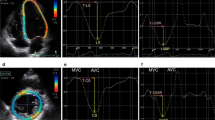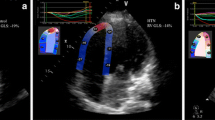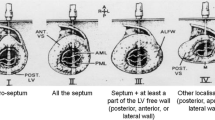Abstract
We examined whether there is a relationship between repolarization abnormalities on electrocardiography (EKG) and deformation abnormalities by echocardiography. Analysis of baseline EKGs and mechanical (echo-based deformation) changes was performed in 128 patients with a clinical diagnosis of hypertrophic cardiomyopathy (HCM). Patients with left ventricular hypertrophy (LVH) or repolarization abnormalities had higher septal thickness when compared to patients with normal EKG. Patients with EKG evidence of LVH or QTc prolongation had lower systolic velocity, systolic strain, systolic strain rate, late diastolic velocity, and late diastolic strain rate than patients with a normal EKG. Patients with strain pattern or ST depression/T-wave inversion had lower systolic velocity, systolic strain, systolic strain rate, early diastolic velocity, and late diastolic velocity when compared to patients with normal EKGs. LVH and repolarization abnormalities on surface EKG are markers of impaired systolic and diastolic mechanics in HCM.






Similar content being viewed by others
References
Maron, B. J. (2002). Hypertrophic cardiomyopathy: a systematic review. Journal of the American Medical Association, 287(10), 1308–1320.
Serri, K., Reant, P., Lafitte, M., Berhouet, M., Le Bouffos, V., Roudaut, R., & Lafitte, S. (2006). Global and regional myocardial function quantification by two-dimensional strain: application in hypertrophic cardiomyopathy. Journal of the American College of Cardiology, 47(6), 1175–1181. doi:10.1016/j.jacc.2005.10.061.
Yang, H., Sun, J. P., Lever, H. M., Popovic, Z. B., Drinko, J. K., Greenberg, N. L., Shiota, T., Thomas, J. D., & Garcia, M. J. (2003). Use of strain imaging in detecting segmental dysfunction in patients with hypertrophic cardiomyopathy. Journal of the American Society of Echocardiography, 16(3), 233–239. doi:10.1067/mje.2003.60S0894731702745367.
Sengupta, P. P., Mehta, V., Arora, R., Mohan, J. C., & Khandheria, B. K. (2005). Quantification of regional nonuniformity and paradoxical intramural mechanics in hypertrophic cardiomyopathy by high frame rate ultrasound myocardial strain mapping. Journal of the American Society of Echocardiography, 18(7), 737–742. doi:10.1016/j.echo.2005.03.008.
Ganame, J., Mertens, L., Eidem, B. W., Claus, P., D'Hooge, J., Havemann, L. M., McMahon, C. J., Elayda, M. A., Vaughn, W. K., Towbin, J. A., Ayres, N. A., & Pignatelli, R. H. (2007). Regional myocardial deformation in children with hypertrophic cardiomyopathy: morphological and clinical correlations. European Heart Journal, 28(23), 2886–2894. doi:10.1093/eurheartj/ehm444.
Nass, R. D., Aiba, T., Tomaselli, G. F., & Akar, F. G. (2008). Mechanisms of disease: ion channel remodeling in the failing ventricle. Nature Clinical Practice. Cardiovascular Medicine, 5(4), 196–207. doi:10.1038/ncpcardio1130.
Franz, M. R., Bargheer, K., Rafflenbeul, W., Haverich, A., & Lichtlen, P. R. (1987). Monophasic action potential mapping in human subjects with normal electrocardiograms: direct evidence for the genesis of the T wave. Circulation, 75(2), 379–386.
Shah, M., Akar, F. G., & Tomaselli, G. F. (2005). Molecular basis of arrhythmias. Circulation, 112(16), 2517–2529. doi:10.1161/CIRCULATIONAHA.104.494476.
Eriksson, M. J., Sonnenberg, B., Woo, A., Rakowski, P., Parker, T. G., Wigle, E. D., & Rakowski, H. (2002). Long-term outcome in patients with apical hypertrophic cardiomyopathy. Journal of the American College of Cardiology, 39(4), 638–645.
Sokolow, M., & Lyon, T. P. (1949). The ventricular complex in left ventricular hypertrophy as obtained by unipolar precordial and limb leads. American Heart Journal, 37(2), 161–186.
Molloy, T. J., Okin, P. M., Devereux, R. B., & Kligfield, P. (1992). Electrocardiographic detection of left ventricular hypertrophy by the simple QRS voltage-duration product. Journal of the American College of Cardiology, 20(5), 1180–1186.
Straus, S. M., Kors, J. A., De Bruin, M. L., van der Hooft, C. S., Hofman, A., Heeringa, J., Deckers, J. W., Kingma, J. H., Sturkenboom, M. C., Stricker, B. H., & Witteman, J. C. (2006). Prolonged QTc interval and risk of sudden cardiac death in a population of older adults. Journal of the American College of Cardiology, 47(2), 362–367. doi:10.1016/j.jacc.2005.08.067.
Roman, M. J., Kligfield, P., Devereux, R. B., Niles, N. W., Hochreiter, C., Halle, A., Sato, N., & Borer, J. S. (1987). Geometric and functional correlates of electrocardiographic repolarization and voltage abnormalities in aortic regurgitation. Journal of the American College of Cardiology, 9(3), 500–508.
Sakamoto, T., Tei, C., Murayama, M., Ichiyasu, H., & Hada, Y. (1976). Giant T wave inversion as a manifestation of asymmetrical apical hypertrophy (AAH) of the left ventricle. Echocardiographic and ultrasono-cardiotomographic study. Japan Heart Journal, 17(5), 611–629.
Yamaguchi, H., Nishiyama, S., Nakanishi, S., & Nishimura, S. (1983). Electrocardiographic, echocardiographic and ventriculographic characterization of hypertrophic non-obstructive cardiomyopathy. European Heart Journal, 4, 105–119. Suppl F.
Fleming, A. D., McDicken, W. N., Sutherland, G. R., & Hoskins, P. R. (1994). Assessment of colour Doppler tissue imaging using test-phantoms. Ultrasound in Medicine and Biology, 20(9), 937–951.
Miyatake, K., Yamagishi, M., Tanaka, N., Uematsu, M., Yamazaki, N., Mine, Y., Sano, A., & Hirama, M. (1995). New method for evaluating left ventricular wall motion by color-coded tissue Doppler imaging: in vitro and in vivo studies. Journal of the American College of Cardiology, 25(3), 717–724. doi:10.1016/0735-1097(94)00421-L.
Urheim, S., Edvardsen, T., Torp, H., Angelsen, B., & Smiseth, O. A. (2000). Myocardial strain by Doppler echocardiography. Validation of a new method to quantify regional myocardial function. Circulation, 102(10), 1158–1164.
Abraham, T. P., Laskowski, C., Zhan, W. Z., Belohlavek, M., Martin, E. A., Greenleaf, J. F., & Sieck, G. C. (2003). Myocardial contractility by strain echocardiography: comparison with physiological measurements in an in vitro model. American Journal of Physiology—Heart and Circulatory Physiology, 285(6), H2599–2604. doi:10.1152/ajpheart.00994.200200994.2002.
Gulati VK, Katz WE, Follansbee WP, Gorcsan J 3rd (1996) Mitral annular descent velocity by tissue Doppler echocardiography as an index of global left ventricular function. American Journal of Cardiology, 77(11), 979–984
Gorcsan, J., 3rd, Strum, D. P., Mandarino, W. A., Gulati, V. K., & Pinsky, M. R. (1997). Quantitative assessment of alterations in regional left ventricular contractility with color-coded tissue Doppler echocardiography. Comparison with sonomicrometry and pressure-volume relations. Circulation, 95(10), 2423–2433.
Greenberg, N. L., Firstenberg, M. S., Castro, P. L., Main, M., Travaglini, A., Odabashian, J. A., Drinko, J. K., Rodriguez, L. L., Thomas, J. D., & Garcia, M. J. (2002). Doppler-derived myocardial systolic strain rate is a strong index of left ventricular contractility. Circulation, 105(1), 99–105.
Voigt, J. U., Arnold, M. F., Karlsson, M., Hubbert, L., Kukulski, T., Hatle, L., & Sutherland, G. R. (2000). Assessment of regional longitudinal myocardial strain rate derived from Doppler myocardial imaging indexes in normal and infarcted myocardium. Journal of the American Society of Echocardiography, 13(6), 588–598.
Nagueh, S. F., Middleton, K. J., Kopelen, H. A., Zoghbi, W. A., & Quinones, M. A. (1997). Doppler tissue imaging: a noninvasive technique for evaluation of left ventricular relaxation and estimation of filling pressures. Journal of the American College of Cardiology, 30(6), 1527–1533.
Sohn, D. W., Chai, I. H., Lee, D. J., Kim, H. C., Kim, H. S., Oh, B. H., Lee, M. M., Park, Y. B., Choi, Y. S., Seo, J. D., & Lee, Y. W. (1997). Assessment of mitral annulus velocity by Doppler tissue imaging in the evaluation of left ventricular diastolic function. Journal of the American College of Cardiology, 30(2), 474–480.
Nagueh, S. F., Sun, H., Kopelen, H. A., Middleton, K. J., & Khoury, D. S. (2001). Hemodynamic determinants of the mitral annulus diastolic velocities by tissue Doppler. Journal of the American College of Cardiology, 37(1), 278–285.
Takemoto, Y., Pellikka, P. A., Wang, J., Modesto, K. M., Cauduro, S., Belohlavek, M., Seward, J. B., Thomson, H. L., Khandheria, B., & Abraham, T. P. (2005). Analysis of the interaction between segmental relaxation patterns and global diastolic function by strain echocardiography. Journal of the American Society of Echocardiography, 18(9), 901–906. doi:10.1016/j.echo.2005.05.008.
Okada, K., Mikami, T., Kaga, S., Onozuka, H., Inoue, M., Yokoyama, S., Nishino, H., Nishida, M., Matsuno, K., Iwano, H., Yamada, S., & Tsutsui, H. (2011). Early diastolic mitral annular velocity at the interventricular septal annulus correctly reflects left ventricular longitudinal myocardial relaxation. European Journal of Echocardiography, 12(12), 917–923. doi:10.1093/ejechocard/jer154.
Pislaru, C., Bruce, C. J., Anagnostopoulos, P. C., Allen, J. L., Seward, J. B., Pellikka, P. A., Ritman, E. L., & Greenleaf, J. F. (2004). Ultrasound strain imaging of altered myocardial stiffness: stunned versus infarcted reperfused myocardium. Circulation, 109(23), 2905–2910. doi:10.1161/01.CIR.0000129311.73402.EF01.CIR.0000129311.73402.EF.
Lang, R. M., Bierig, M., Devereux, R. B., Flachskampf, F. A., Foster, E., Pellikka, P. A., Picard, M. H., Roman, M. J., Seward, J., Shanewise, J. S., Solomon, S. D., Spencer, K. T., Sutton, M. S., & Stewart, W. J. (2005). Recommendations for chamber quantification: a report from the American Society of Echocardiography's Guidelines and Standards Committee and the Chamber Quantification Writing Group, developed in conjunction with the European Association of Echocardiography, a branch of the European Society of Cardiology. Journal of the American Society of Echocardiography, 18(12), 1440–1463. doi:10.1016/j.echo.2005.10.005.
Bacharova L, Michalak K, Kyselovic J, Klimas J (2005) Relation between QRS amplitude and left ventricular mass in the initial stage of exercise-induced left ventricular hypertrophy in rats. Clinical and Experimental Hypertension, 27(6), 533–541. doi:10.1081/CEH-200068802
McLeod, C. J., Ackerman, M. J., Nishimura, R. A., Tajik, A. J., Gersh, B. J., & Ommen, S. R. (2009). Outcome of patients with hypertrophic cardiomyopathy and a normal electrocardiogram. Journal of the American College of Cardiology, 54(3), 229–233. doi:10.1016/j.jacc.2009.02.071.
Kohsaka, S., Sciacca, R. R., Sugioka, K., Sacco, R. L., Homma, S., & Di Tullio, M. R. (2005). Additional impact of electrocardiographic over echocardiographic diagnosis of left ventricular hypertrophy for predicting the risk of ischemic stroke. American Heart Journal, 149(1), 181–186. doi:10.1016/j.ahj.2004.06.006.
Ostman-Smith I, Wisten A, Nylander E, Bratt EL, Granelli AW, Oulhaj A, Ljungstrom E (2010) Electrocardiographic amplitudes: a new risk factor for sudden death in hypertrophic cardiomyopathy. European Heart Journal, 31(4), 439–449
Hsieh, B. P., Pham, M. X., & Froelicher, V. F. (2005). Prognostic value of electrocardiographic criteria for left ventricular hypertrophy. American Heart Journal, 150(1), 161–167.
Antzelevitch C (2007) Ionic, molecular, and cellular bases of QT-interval prolongation and torsade de pointes. Europace, 9(Suppl 4), iv4–15. doi:10.1093/europace/eum166
Rajappan, K., O'Connell, C., & Sheridan, D. J. (2003). Changes in QT interval with exercise in elite male rowers and controls. International Journal of Cardiology, 87(2–3), 217–222.
Yang, K. C., Foeger, N. C., Marionneau, C., Jay, P. Y., McMullen, J. R., & Nerbonne, J. M. (2010). Homeostatic regulation of electrical excitability in physiological cardiac hypertrophy. The Journal of Physiology, 588(Pt 24), 5015–5032. doi:10.1113/jphysiol.2010.197418.
Antzelevitch, C. (2005). Role of transmural dispersion of repolarization in the genesis of drug-induced torsades de pointes. Heart Rhythm, 2(2 Suppl), S9–15. doi:10.1016/j.hrthm.2004.09.011.
Yan, G. X., Lankipalli, R. S., Burke, J. F., Musco, S., & Kowey, P. R. (2003). Ventricular repolarization components on the electrocardiogram: cellular basis and clinical significance. Journal of the American College of Cardiology, 42(3), 401–409.
Klues, H. G., Schiffers, A., & Maron, B. J. (1995). Phenotypic spectrum and patterns of left ventricular hypertrophy in hypertrophic cardiomyopathy: morphologic observations and significance as assessed by two-dimensional echocardiography in 600 patients. Journal of the American College of Cardiology, 26(7), 1699–1708. doi:10.1016/0735-1097(95)00390-8.
Petersen, S. E., Jerosch-Herold, M., Hudsmith, L. E., Robson, M. D., Francis, J. M., Doll, H. A., Selvanayagam, J. B., Neubauer, S., & Watkins, H. (2007). Evidence for microvascular dysfunction in hypertrophic cardiomyopathy: new insights from multiparametric magnetic resonance imaging. Circulation, 115(18), 2418–2425. doi:10.1161/CIRCULATIONAHA.106.657023.
Schumacher, B., Gietzen, F. H., Neuser, H., Schummelfeder, J., Schneider, M., Kerber, S., Schimpf, R., Wolpert, C., & Borggrefe, M. (2005). Electrophysiological characteristics of septal hypertrophy in patients with hypertrophic obstructive cardiomyopathy and moderate to severe symptoms. Circulation, 112(14), 2096–2101. doi:10.1161/CIRCULATIONAHA.104.515643.
Ripplinger, C. M., Li, W., Hadley, J., Chen, J., Rothenberg, F., Lombardi, R., Wickline, S. A., Marian, A. J., & Efimov, I. R. (2007). Enhanced transmural fiber rotation and connexin 43 heterogeneity are associated with an increased upper limit of vulnerability in a transgenic rabbit model of human hypertrophic cardiomyopathy. Circulation Research, 101(10), 1049–1057. doi:10.1161/CIRCRESAHA.107.161240.
Marian, A. J. (2008). Genetic determinants of cardiac hypertrophy. Current Opinion in Cardiology, 23(3), 199–205. doi:10.1097/HCO.0b013e3282fc27d900001573-200805000-00006.
Acknowledgments
Funding for this study was provided by National Institutes of Health grant # HL 098046. Dr. Lin was partially supported by the China Scholarship Council. The experiments comply with the current laws of the USA.
Author information
Authors and Affiliations
Corresponding author
Additional information
Associate Editor: Jozef Bartunek oversaw the review of this article
Xiaoping Lin and Hsin-Yueh Liang contributed equally to this work.
Rights and permissions
About this article
Cite this article
Lin, X., Liang, HY., Pinheiro, A. et al. Electromechanical Relationship in Hypertrophic Cardiomyopathy. J. of Cardiovasc. Trans. Res. 6, 604–615 (2013). https://doi.org/10.1007/s12265-013-9481-0
Received:
Accepted:
Published:
Issue Date:
DOI: https://doi.org/10.1007/s12265-013-9481-0




